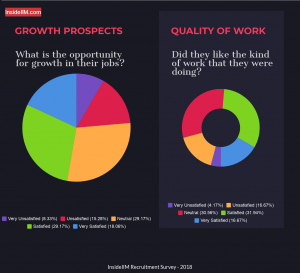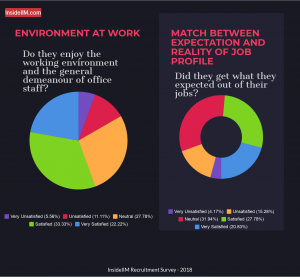You can find the figures below, followed by individual analysis of the parameters:
I)

Compensation
The data suggest that Alumni are actually less satisfied than what they were last year. However, there is a rise in satisfaction as compared to 2015.
Regardless of any comparison, 80% satisfaction (including neutral opinions) from those who have spent a fortune on their MBA education is quite a reassuring figure.
The report proves that contrary to popular belief, people are actually happy with the remuneration that they receive.
Work-Life Balance:
The Work-Life balance figures have risen in favour of the number of Alumni who are not just satisfied, but very satisfied with the number of hours they get outside of work.
When looked at individually, only 12% of them are actually not happy with their jobs as opposed to 65% who are quite happy. This is a motivating figure for those who fear that jobs after an MBA are all work and no play.
Another perspective on this is that perhaps the concept of Work-Life Balance is not a very well understood concept and the statistics indicate that maybe people feel it is ok to work 80 hours a week - something which a lot of MBA graduates do in certain roles.
II)

Growth Prospects:
78% of the respondents (including those with a neutral opinion) are more-or-less happy with the growth prospects that their respective organisations have to offer.
However, when compared to 2016's figures, there is a drop from 64% Satisfaction level to 47%, which is a drop 17 percentage points. While not a red-flag, this is a little alarming for companies as this figure can very easily influence attrition rates.
Quality of Work:
While there is a decline in the percentage of Alumni who are unhappy as compared to 2016 and 2015, it is compensated for by a decline in the number of people who are satisfied. There is a rise in the number of people who are Neutral about this. This is a good figure and is consistent with what one can expect after graduating from a top b-school.
III)

Work Environment:
A decline is seen in satisfaction percentage, which is compensated for with a decline in dissatisfaction. However, more people are of a neutral opinion as compared to 2016.
Match Between Expectations And Reality Of Job Profile:
The figures here suggest that most of the respondents got what they expected in terms of their role. Including the neutral perspective, there is a marginal increase in Satisfaction as compared to last year. This suggests that companies are generally communicating well with the b-school alumni by painting a clear picture of the job profile, but there is room for improvement.
The analysis finds that, barring a few parameters, the statistics of this year are similar to that of 2015. The overall analysis suggests that the Alumni are generally happy with the roles that they have in their respective organisations. However, one observation that comes as a red-flag is a significant shift of opinion from Satisfied to Neutral. This suggests that while a majority of Alumni are not dissatisfied, they could be inclined to feel so in the future. But could this figure further translate into a less than positive opinion of companies?
You can see our reports on How Much Does It Cost To Do An MBA In 2018? and What Is The All-Inclusive Reasonable Cost Of Doing An MBA?
If you have any questions or want to talk about your experiences as a b-school alumnus, let us know in the comments section.


















Comments